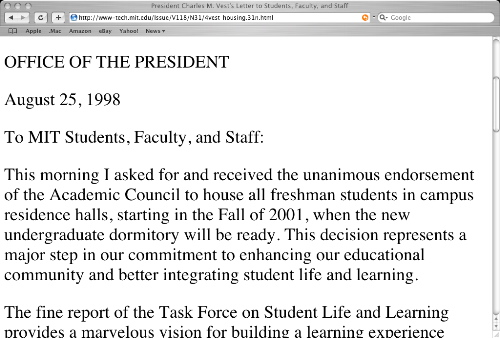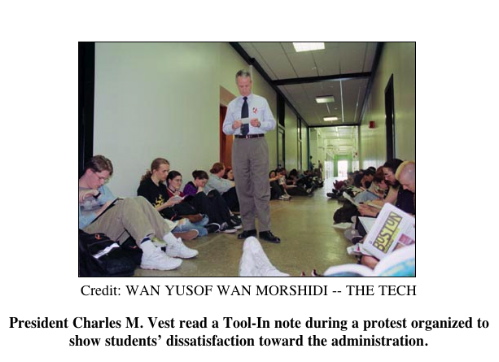|
CREATING LIFE FROM A SPONGE: THE PRE-HISTORY OF SIMMONS HALL
by JEFF ROBERTS
APRIL 2, 2004
2. EARLY CHALLENGES

We knew from early on that our task would be a difficult one.
Some challenges were already waiting for us when the group was
formed. The first challenge also happened to be the reason
why Simmons Hall was being built in the first place. To make a
long story short: In the fall of 1997, a
freshman at an MIT fraternity house died of alcohol poisoning.
This precipitated a chain of
events that I won't go into describing-- some of you might know the
story anyway-- and resulted in MIT changing its policy on whether or
not freshmen are allowed to live in fraternities. In August 1998,
just
after I arrived on campus as a freshman, the president of MIT announced
that starting in the fall of 2001, all freshmen would be required to
live in dorms. Because MIT did not have enough housing to handle
this
increase-- about 300 freshmen moved into fraternities or independent
living groups each year-- MIT needed to build a new dorm. Thus,
"Residence 2001" was born.

For obvious reasons, the "freshmen-on-campus" decision was extremely
unpopular among students,
particularly the approximately one-third of students who lived in
fraternities, sororities, and independent living groups. Students
in dormitories did not care for it either, since most students
appreciated having the ability to choose their living
environment. A student crusade of sorts had built up following
the
decision, with many people feeling that it was an
attempt by the administration to take away students' very freedom and
bring them under closer oversight and control by the
administration. And this new dorm would be the concrete,
living, breathing manifestation of the MIT administration's attempt to
destroy everything that once was special and great about student life
at MIT. Needless to say, there was not a high level of support
for the new dorm from within the community it was intended to serve.
As another complication, the actual program development for the
building itself was already underway when the Founders Group was
formed. The MIT Planning Office,
working with consultant Richard Dober and a group of student leaders,
had already gone through the process of space planning, which is
essentially a description of what is
supposed to go into a building in terms of numbers-- x square feet of
the building will be a, y square feet of the building will be b, and so
on. Many of the innovations that people talk about with regards
to
Simmons Hall-- the large amount of common space, the large dining hall
area and night cafe, the visiting scholar apartments-- were developed
as part of this process long before the architects were ever
involved. Since we on the Founders Group did not play any role in
this process, it was somewhat difficult at times to work with and
advise the architectural program, especially in situations where we
found that our views were not the same as the space planning team.
Yet another large complication, which in many ways would turn out to be
the largest, was that before the Founders Group was formed, MIT
selected Steven Holl to
be the new dorm's designer. Normally, one would want the
formation of a
client group to precede-- even assist with-- the selection of an
architect. But there were a few differences in this case-- first,
the timetable was
short and decisions needed to be made, and second, MIT's leadership
already had a strong idea of what it wanted. Steven Holl, known
for his innovative and unconventional designs, was at the time already
one of the most famous architects in the world. When MIT hired
Holl, it was clear that it was looking for an unique, "signature" piece
for the campus that would attract attention from the design community
and the world at large. According to MIT's leadership, hiring
Holl to design a new dormitory represented MIT's renewed commitment to
investing in student
life and student housing as specified by the aforementioned Task Force
on Student Life and Learning. I had heard that Steven Holl didn't
have any experience in
designing student housing and had designed very little housing at
all.
But I also heard that he was supposed to be a genius, so I was willing
to give him the benefit of the
doubt at first.
copyright Jeffrey C. Roberts, 2004 |